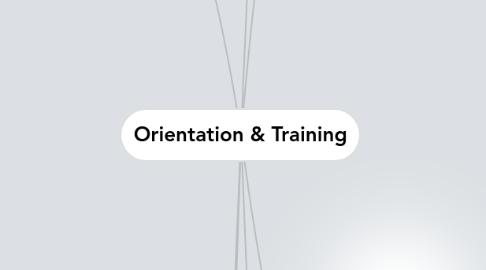
1. Orienting Employees
1.1. ORIENTATION - long term - Socialization process b/w employee & employer
1.2. Purpose of orientation programs
1.2.1. EMPLOYEE ORIENTATION (ONBOARDING) - A procedure for providing new employees w/ basic background information about
1.2.1.1. The firm
1.2.1.2. The job
1.2.2. SOCIALIZATION - The ongoing process of instilling in all employees the prevailing attitudes, standards, values & patterns of behaviour that are expected by the organization
1.2.3. Reduce REALITY SHOCK (COGNITIVE DISSONANCE) - The state that results from the discrepancy b/w that the new employee expected from his or her new job & the realities of it
1.2.4. Foundation for ongoing performance management
1.2.5. Improved productivity
1.2.6. Improved retention levels & reduced recruitment costs
1.3. Content of orientation programs
1.3.1. Internal publications (handbooks, newsletters, company history)
1.3.2. Facility tour & staff introductions
1.3.3. Job-related documents & explanation of duties, resonsibilities
1.3.4. Expected training to be received
1.3.5. Performance appraisal criteria
1.4. Responsibility for orientation
1.4.1. HR specialist
1.4.1.1. Explains corporate information
1.4.1.2. Follows up over time
1.4.2. Supervisor
1.4.2.1. Explains nature of the job
1.4.2.2. Intro of colleagues
1.4.3. Buddy or mentor
1.4.3.1. Assists w/ day-to-day items
1.5. Special orientation situations
1.5.1. Diverse workforce
1.5.2. Managers & acquisitions
1.5.3. Union vs. non-union employees
1.5.4. Multi-location organizations
1.6. Problems w/ orientation programs
1.6.1. Too much info in a short time can overwhelm
1.6.2. Too many forms to fill out
1.6.3. Little or no orientation provided
1.6.4. HR info can be too broad; supervisor's info can be too detailed
1.7. Evaluation of orientation programs
1.7.1. 1. Employee reaction
1.7.1.1. Evaluate usefulness, job performance
1.7.1.2. Socialization effects
1.7.1.3. Assess progress towards understanding norms
1.7.1.4. Cost/benefit analysis
1.7.1.5. Compare costs of program (ex. materials, time) to benefits (fewer errors, rate of productivity)
1.7.2. 2. Socialization effects
1.7.3. 3. Cost/benefit analysis
1.8. Executive integration
1.8.1. Process
1.8.1.1. Identify position specifications
1.8.1.2. Provide realistic information to candidates
1.8.1.3. Assess candidate's previous success w/ integration
1.8.1.4. Announce hiring w/ enthusiasm
1.8.1.5. Stress importance of listening & demonstrating competency
1.8.1.6. Assist mew executives w/ cultural norms & change
2. Step 5: Evaluation of Training
2.1. Training effects to measure
2.1.1. 1. Reaction
2.1.1.1. Were trainees satisfied?
2.1.2. 2. Learning
2.1.2.1. Did trainees learn what was intended?
2.1.3. 3. Behaviour
2.1.3.1. Was training transferred to the job?
2.1.4. 4. Results
2.1.4.1. Did training deliver intended results in the organization?
2.2. CONTROLLED EXPERIMENTATION - Formal methods for testing the effectiveness of a training program, preferably w/ a control group & with tests before & after training
3. Training for Special Purposes
3.1. Literacy & essential skills training
3.1.1. Functional literacy declining
3.2. Training for global business & diverse workforces
3.2.1. Global literacies: personal, social, business, cultural
3.3. Customer service training
3.3.1. Customer service certification program
3.4. Training for teamwork
3.4.1. Ex. Outward Bound
3.5. Training for first-time supervisors/managers
3.5.1. Increasing turnover
4. The Training Process
4.1. TRAINING - short term - The process of teaching employees the basic skills/competencies that they need to perform their jobs
4.2. Learning styles
4.2.1. Auditory
4.2.2. Visual kinesthetic
4.3. Personalize learning
4.3.1. Meaningful material
4.3.2. Maximize similarity of training to job
4.3.3. Motivate trainees
4.4. Legal aspects of training
4.4.1. Avoid discrimination
4.4.2. Avoid negligent training
4.5. The five-step training process
5. Step 1: Training Needs Analysis
5.1. TASK ANALYSIS - A detailed study of a job to identify the skills & competencies it requires so that an appropriate training program can be instituted
5.1.1. New employees
5.2. PERFORMANCE ANALYSIS - Verifying that there is a performance deficiency & determining whether that deficiency should be recertified through training or through some other means ex. transferring employee
5.2.1. Current employees
5.3. Task analysis: assessing the training needs of new employees
5.3.1. Task analysis record form
5.4. Performance analysis: determining the training needs of current employees
5.5. Needs analysis output
5.5.1. Training objectives
5.5.1.1. Specify what the trainee should be able to accomplish after completing the training
5.5.1.2. Provide focus for trainee & trainer
5.5.1.3. Provide a benchmark for evaluation of the training program
6. Step 2: instructional Design
6.1. Process
6.1.1. Prepare curriculum
6.1.2. Ensure that training materials support learning objectives
6.1.3. Ensure the quality & effectiveness of program elements
6.2. Traditional training techniques
6.2.1. On-the-job training
6.2.2. Apprenticeship training
6.2.3. Informal learning
6.2.4. Job instruction training
6.2.5. Classroom training
6.2.6. Audiovisual techniques
6.2.6.1. VIDEOCONFERENCING - Connecting two or more distant groups by using audiovisial equipment
6.2.7. PROGRAMMED LEARNING - A systematic method for teaching job skills that involves presenting questions or facts, allowing the person to respond & giving the learner immediate feedback on the accuracy of his or her answers
6.2.8. VESTIBULE or SIMULATED TRAINING - Training employees on special off-the-job equipment, as in airplane pilot training, whereby training costs & hazards can be reduced
6.3. E-LEARNING - Delivery & administration of learning opportunities & support via computer, networked & web-based technology to enhance employee performance & development
6.3.1. Flexible, personalized, cost-effective
6.3.2. Types
6.3.2.1. Computer-based training
6.3.2.2. ELECTRONIC PERFORMANCE SUPPORT SYSTEMS (EPSS) - Computer-based job aids, or sets of computerized tools & displays
6.3.2.3. Online training
7. Steps 3 & 4: Validation & Implementation
7.1. Step 3: Validation
7.1.1. Often-overlooked step
7.1.2. Ensures that objectives are accomplished
7.1.3. Pilot study or run-through using representative audience
7.1.4. Collect feedback & assess participats
7.1.5. Make revisions based on results
7.2. Step 4: Implementation
7.2.1. Roll out or schedule delivery by professional trainers
7.2.2. Train-the-trainer workshops may be required
7.2.3. Ensure trainers are familiar w/ content & presentation methods
